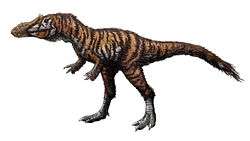Qianzhousaurus
| Qianzhousaurus Temporal range: Maastrichtian, 72–66 Ma | |
|---|---|
 | |
| Restoration | |
| Scientific classification | |
| Kingdom: | Animalia |
| Phylum: | Chordata |
| Class: | Reptilia |
| Clade: | Dinosauria |
| Order: | Saurischia |
| Suborder: | Theropoda |
| Family: | †Tyrannosauridae |
| Subfamily: | †Tyrannosaurinae |
| Tribe: | †Alioramini |
| Genus: | †Qianzhousaurus Lü et al., 2014 |
| Type species | |
| †Qianzhousaurus sinensis Lü et al., 2014 | |
Qianzhousaurus is a genus of tyrannosaurid dinosaur. There is currently only one species named, the type species Qianzhousaurus sinensis.[1] Nicknamed "Pinocchio rex" for its long snout in comparison with other known tyrannosaurs, it was discovered in southern China and first published in the journal Nature Communications in May 2014. [2] Aside from its signature snout, it also had long, narrow teeth, while T. rex had thick teeth and powerful, deep-set jaws. The bones were discovered by workmen at a construction site near the city of Ganzhou, who then took them to a local museum.[3]
Lead author Professor Lü Junchang from the Institute of Geology, Chinese Academy of Geological Sciences stated that "the new discovery is very important. Along with Alioramus from Mongolia, it shows that the long-snouted tyrannosaurids were widely distributed in Asia. Although we are only starting to learn about them, the long-snouted tyrannosaurs were apparently one of the main groups of predatory dinosaurs in Asia."[4] The existence of long-snouted tyrannosaurs was previously suspected due to other inconclusive fossil finds, that could be explained as the juveniles of short-snouted species, but co-author Stephen L. Brusatte from the University of Edinburgh reveals that the find "tells us pretty unequivocally that these long-snouted tyrannosaurs were a real thing. They were a different breed, living right at the end of the age of dinosaurs."[5] Examination of the rock encasing the Fossil shows it is probably from the Red Beds of the Nanxiong Formation, which date to the Cretaceous–Paleogene boundary about 72-66 million years ago.
Classification
The discovery of Qianzhousaurus led to a new branch of the tyrannosaur family being named, consisting of the long-snouted Q. sinensis and the two known species of Alioramus. This clade, named the Alioramini, had an uncertain placement relative to other members of the tyrannosaur branch in the initial analysis that discovered it. The primary phylogenetic analysis found Alioramini to be closer to Tyrannosaurus than to Albertosaurus, and therefore a member of the group Tyrannosaurinae. However, a second analysis in the same paper found it to be located outside of the clade including Albertosaurinae and Tyrannosaurinae, and therefore the sister group of Tyrannosauridae.[1]
Below is the first analysis found by the authors:[1]
| Tyrannosauridae |
| |||||||||||||||||||||||||||||||||||||||||||||
| |
See also
References
- 1 2 3 Junchang Lü, Laiping Yi, Stephen L. Brusatte, Ling Yang, Hua Li & Liu Chen, 2014, "A new clade of Asian Late Cretaceous long-snouted tyrannosaurids", Nature Communications 5, Article number: 3788 doi:10.1038/ncomms4788
- ↑ "Pinocchio rex long-snouted tyrannosaur discovered in Asia - Technology & Science - CBC News". Cbc.ca. 2014-05-07. Retrieved 2014-05-22.
- ↑ Dinosaurs (2014-05-07). "Long-nosed 'Pinocchio rex' dinosaur discovered by scientists". London: Telegraph. Retrieved 2014-05-22.
- ↑ "Qianzhousaurus sinensis: Long-Snouted Tyrannosaur Discovered in China | Paleontology". Sci-News.com. 2014-05-07. Retrieved 2014-05-22.
- ↑ Jacqueline Howard (2014-05-07). "'Pinocchio Rex' Dinosaur Unearthed In China Confirms Theory About Tyrannosaurs". Huffingtonpost.com. Retrieved 2014-05-22.
